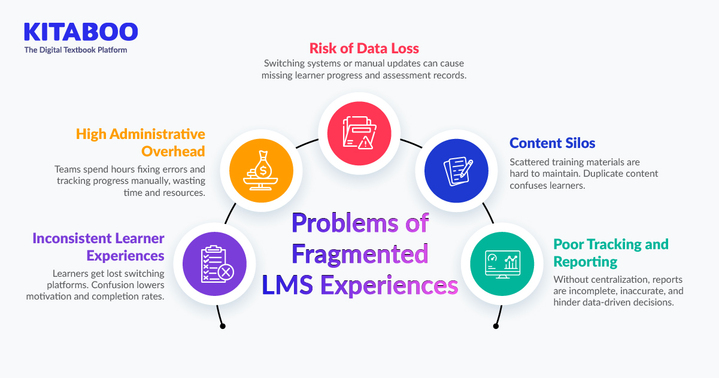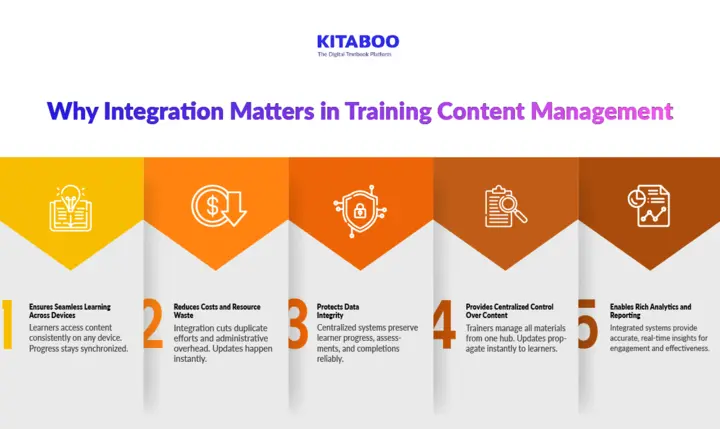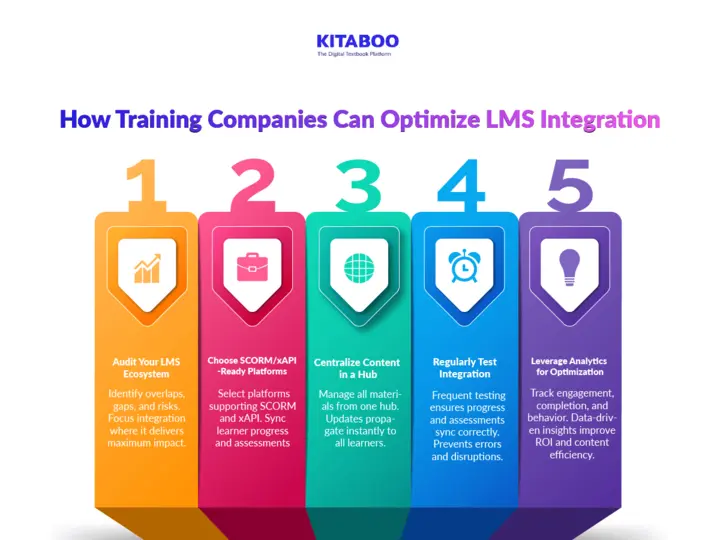
From LMS Chaos to Seamless Learning: How to Integrate Training Content Without Losing Data
Summarize this blog with your favorite AI:
How to Integrate Training Content Without Losing Data – TL;DR
Fragmented LMS platforms create confusion, slow training, and increase data loss risks. Learners struggle, teams spend hours fixing issues, and organizations lose valuable resources.
Without proper integration, training programs fail to deliver seamless learning experiences.
Integrating training content with platforms like KITABOO centralizes training content management, automates progress tracking, and ensures updates propagate instantly.
Learners receive consistent experiences, teams work efficiently, and organizations save costs. Proper LMS integration transforms chaotic systems into scalable, measurable, and engaging programs.
This table summarizes the key takeaways on how integrating training content improves learning, reduces costs, and prevents data loss.
| Focus Area | Challenges with Fragmented LMS | Benefits of KITABOO Integration |
|---|---|---|
| Learners | Confusion, interrupted progress, low engagement | Seamless learning, consistent content, higher completion rates, better engagement |
| Training Teams | High administrative overhead, manual tracking, and fragmented content | Centralized training content management, reduced manual work, streamlined updates, and accurate analytics |
| Organizations | Operational inefficiency, compliance risks, wasted resources | Cost savings, prevention of data loss, measurable ROI, scalable training programs |
| Content Delivery | Multiple platforms, slow updates, errors | Instant content updates, centralized hub, real-time tracking, improved learner experience |
| Data & Reporting | Lost progress, inconsistent reporting | Accurate data tracking, reliable analytics, informed decision-making, audit-ready compliance |
Are your learners struggling to keep up while your training team spends hours fixing LMS issues?
Fragmented platforms, missing data, and inconsistent experiences create chaos. Every manual update risks data loss, and every system switch delays learning. Training becomes stressful instead of effective, and productivity drops.
The good news is you can change this. By choosing to integrate training content properly, you bring all your resources together.
Smart LMS integration ensures learners experience seamless learning, progress is tracked accurately, and content updates happen instantly. Platforms like KITABOO centralize materials, simplify training content management, and turn chaotic systems into smooth, efficient learning environments.
Table of Contents
What are the Problems of Fragmented LMS Experiences?
Fragmented LMS platforms are a serious threat to training programs. Switching between systems wastes time and creates confusion.
1. Inconsistent Learner Experiences
Learners get lost when content spreads across multiple platforms. Progress is interrupted frequently. The confusion and uncertainty end up frustrating learners and lowering their motivation.
Completion rates drop sharply, affecting learning success. Disconnected experiences prevent seamless learning across teams.
2. High Administrative Overhead
Training teams spend hours fixing system errors and tracking progress manually. Valuable time is wasted on repetitive tasks. Staff focus shifts from improving content to firefighting issues.
Costs rise as teams struggle to manage multiple platforms. Administrative burden creates stress and slows program delivery.
3. Risk of Data Loss
Every system switch or manual update increases data loss risk. Learner progress and assessment records can disappear. Missing data affects compliance tracking and reporting accuracy.
Decisions become guesswork without reliable information. Organizations face potential penalties and reputational damage.
4. Content Silos
Training materials scattered across platforms are difficult to update and maintain. Duplicate or outdated content causes confusion among learners. Teams spend extra hours syncing materials manually.
Siloed content prevents smooth content delivery. This disrupts training content management and wastes resources.
5. Poor Tracking and Reporting
Without a centralized system, tracking learner progress is inconsistent. Reports are incomplete and inaccurate. Managers cannot make data-driven decisions efficiently.
Resource allocation suffers, increasing operational costs. Lack of visibility reduces program effectiveness and learner outcomes.
Why Integration Matters in Training Content Management
If you fail to integrate training content with LMS, learning programs face inefficiency and wasted resources. Centralized systems are essential to protect content, track progress, and enable seamless learning.
1. Ensures Seamless Learning Across Devices
Integrated systems allow learners to access content consistently on any device. No interruptions or confusion occur. Progress remains synchronized, supporting engagement and completion.
Learners enjoy uninterrupted access, enhancing retention. Seamless experiences reduce frustration and improve outcomes.
2. Reduces Costs and Resource Waste
Proper integration minimizes administrative overhead and duplicate efforts. Teams spend less time fixing system issues. Content updates happen instantly without reprints or manual syncing.
Reduced errors save both time and money. Organizations achieve higher efficiency and measurable cost savings.
3. Protects Data Integrity
Centralized platforms prevent data loss during content updates or system transitions. Learner progress, assessments, and completions are preserved.
Compliance reporting remains accurate and reliable. Training teams can trust the data. Accurate records improve decision-making and program credibility.
4. Provides Centralized Control Over Content
Integration allows trainers to manage all materials from one hub. Updates propagate instantly to all learners. Duplicate or outdated content is eliminated.
Content management systems help teams save time and reduce errors. Centralized control improves training content management and operational efficiency.
5. Enables Rich Analytics and Reporting
Integrated systems provide real-time insights into learner performance. Metrics track engagement, completion, and content effectiveness. Reports are accurate, actionable, and reliable.
Trainers can identify gaps and optimize programs. Analytics support data-driven decisions and maximize ROI.
How Does KITABOO Enable Seamless LMS Integration?
KITABOO helps training companies integrate training content with their existing LMS systems effortlessly. Integration ensures seamless learning, protects against data loss, and centralizes training content management. Teams save time, reduce errors, and deliver engaging experiences.
Here’s how KITABOO makes LMS integration easy, effective, and efficient.
1. SCORM & xAPI Compliance
KITABOO supports SCORM and xAPI, ensuring content works with any LMS. Learner progress and assessments sync automatically.
Updates happen instantly, reducing manual work. Compliance remains accurate, preventing data loss. Integration avoids costly system overhauls.
2. Smooth Data Flow
Learner progress, completions, and scores move automatically between KITABOO and LMS. No data gets lost. Trainers gain real-time visibility into learner activity. Seamless syncing reduces administrative overhead. Teams can focus on improving content quality.
3. Offline Tracking
KITABOO tracks offline activity and pushes it once learners reconnect. Training continues uninterrupted regardless of connectivity.
Learner engagement remains high. Administrators get full visibility into offline progress. This prevents loss of data even in remote locations.
4. LTI Support and Tool Integration
KITABOO integrates with LTI-compliant tools, Google Classroom through the SSO option, and Amazon Polly. KITABOO also integrates with the Moodle platform seamlessly.
Content delivery remains consistent across platforms. Learners enjoy enriched, engaging experiences. Integration avoids duplicate systems and saves time.
5. Analytics & Reporting
KITABOO preserves rich analytics and reporting even after integration. Progress, completion rates, and engagement data remain visible. The KITABOO Training Hub also enables learners to track personal goals and learning progress.
Managers can make informed, data-driven decisions. Centralized insights improve training content management. Accurate reporting reduces operational errors and costs.
Beyond integration, the KITABOO Training Hub serves as the control center for learning activities. It helps trainers assign courses, track learner progress, and manage certifications in one place. Connecting your LMS with the Training Hub ensures smooth data flow across all systems.
The KITABOO Training Hub centralizes the learning process. It enhances engagement through personalized learning paths and promotes structured learning.
Learners experience consistent and seamless learning on any device. The Training Hub transforms KITABOO into a complete learning ecosystem with integration, analytics, and engagement tools.
How to Guide:
How to Integrate your LMS with KITABOO?
How Can Training Companies Optimize LMS Integration?
Reducing chaos and inefficiency in training content management requires smart planning. Proper integration improves learner experience, prevents data loss, and supports seamless learning.
Here are actionable tips to make it happen.
1. Audit Your LMS Ecosystem
Review all existing LMS platforms and tools. Identify overlaps, gaps, and potential inefficiencies. Understand where content is fragmented and data privacy risks exist.
Map the systems your learners and trainers use most. This audit highlights areas where integration can deliver maximum impact.
2. Choose SCORM/xAPI-Ready Platforms
To effortlessly integrate training content, select platforms like KITABOO that fully support SCORM and xAPI. Integration ensures learner progress and assessments sync automatically. This prevents data and improves reporting accuracy.
Platforms should support seamless learning across devices. Choosing compliant systems reduces administrative workload and future headaches.
3. Centralize Content in a Hub
Before pushing content to multiple LMSs, centralize materials in a single hub. Centralization improves training content management and ensures updates propagate instantly. Learners access consistent and accurate content every time.
Teams can manage multimedia, assessments, and modules efficiently. A central hub also prevents duplicate work and errors.
4. Regularly Test Integration
Frequent testing ensures learner progress, assessments, and completions sync correctly. Identify gaps or errors before they impact seamless learning. Testing protects against loss of data and prevents workflow disruptions.
Regular checks keep systems reliable for both learners and training teams. Timely intervention maintains program credibility and effectiveness.
5. Leverage Analytics for Optimization
Use integrated platform analytics to track engagement, completion, and learner behavior. Insights help optimize content, schedules, and training methods. Managers can make data-driven decisions, improving ROI and reducing costs.
Analytics prevent resource waste and support better training content management. Data visibility ensures programs remain efficient, scalable, and impactful.
Conclusion
Fragmented LMS platforms create chaos, inefficiency, and risk of data loss. Training programs suffer. Learners get frustrated, teams waste time, and organizations lose ROI.
The solution is to integrate training content with platforms like KITABOO. Smart LMS integration enables seamless learning, centralized training content management, and accurate tracking. Learners enjoy consistent experiences, teams work efficiently, and organizations save costs.
Start centralizing and integrating your training content today. Reduce errors, protect data, and improve learning outcomes. A unified system like KITABOO ensures training programs scale smoothly and deliver measurable impact.
FAQs
It means connecting all your courses, modules, and materials with your LMS. This ensures seamless learning and avoids data loss.
Integration prevents content duplication, reduces manual work, and helps track employee progress accurately.
Learners get consistent access to training materials without switching platforms. This supports seamless learning.
Yes. Integration ensures all completions, scores, and assessments sync automatically with the LMS.
Manual updates, repeated tasks, and platform juggling are minimized, freeing teams to focus on training quality.
KITABOO supports SCORM and xAPI compliance, LTI integration, offline tracking, and analytics. It syncs learner progress automatically, preventing data loss.
Discover how a mobile-first training platform can help your organization.
KITABOO is a cloud-based platform to create, deliver & track mobile-first interactive training content.





